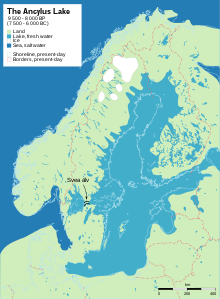Maglemosian culture
 | |
| Geographical range | Europe |
|---|---|
| Period | Mesolithic Europe |
| Dates | c. 9000 – c. 6000 BC |
| Preceded by | Ahrensburgian Fosna–Hensbacka culture Swiderian culture |
| Followed by | Kongemose culture |
| The Mesolithic |
|---|
| ↑ Upper Paleolithic |
| ↓ Neolithic |
Maglemosian (c. 9000 – c. 6000 BC) is the name given to a culture of the early Mesolithic period in Northern Europe. In Scandinavia, the culture was succeeded by the Kongemose culture.
Environment and location
[edit]The name originates from the Danish archeological site Maglemose, situated near Gørlev and Høng on western Zealand, southwest of lake Tissø. Here the first settlement of the culture was excavated in 1900, by George Sarauw.[1] During the following century a long series of similar settlements were excavated from England to Poland and from Skåne in Sweden to northern France.
When the Maglemosian culture flourished, sea levels were much lower than now and what is now mainland Europe and Scandinavia were linked with Britain. The cultural period overlaps the end of the last ice age,[2] when the ice retreated and the glaciers melted. It was a long process and sea levels in Northern Europe did not reach current levels until almost 6000 BC, by which time they had inundated large territories previously inhabited by Maglemosian people. Therefore, there is hope that the emerging discipline of underwater archaeology may reveal interesting findings related to the Maglemosian culture in the future.
Characteristics
[edit]The Maglemosian people lived in forest and wetland environments, using fishing and hunting tools made from wood, bone, and flint microliths. It appears that they had domesticated the dog.[3] Some may have lived settled lives, but most were nomadic.[citation needed]
Huts made of bark have been preserved, in addition to tools made of flint, bone, and horn. A characteristic feature of the culture is the sharply edged microliths of flintstone, used for spear and arrow heads.[4] Another notable feature is the leister, a characteristic type of fishing spear, used for gigging.
Scandinavian data table
[edit]| Era | Timespan | Climatic period | Plantgrowth | Mammal game | Bird game | Locale type |
|---|---|---|---|---|---|---|
| Early Maglemosian culture | 9,000 BC – 7,800 BC | Preboreal Epoch | Birch-pine era | aurochs, bison, elk, wild horse | crane, lapwing | |
| Middle Maglemosian culture | 7,800 BC – 7,000 BC | Boreal Epoch | Hazel-pine era | aurochs, red deer, roe deer, wild boar, lynx, fox, polecat, badger, wildcat | merganser, grebe, coot, heron, crane, lapwing | Klosterlund |
| Late Maglemosian culture | 7,000 BC – 6,400 BC | Atlantic Epoch | Later linden era | aurochs, red deer, roe deer, wild boar, lynx, fox, polecat, badger, wildcat | merganser, grebe, coot, heron, crane, lapwing |
Genetics
[edit]See also
[edit]- Ahrensburg culture
- Deepcar
- Doggerland
- Koelbjerg Man
- Last glacial period
- Georg F.L. Sarauw
- Star Carr
- Thatcham
References
[edit]- ^ Sarauw, G. F. L. (1903). "En Stenaldersboplads i Maglemose ved Mullerup – sammenholdt med beslægtede fund" [A Stone Age settlement in Maglemose near Mullerup – compared with related finds. Resumé: Études sur le premier âge de la pierre du Nord de l'Europe]. Aarbøger for Nordisk Oldkyndighed og Historie (in Danish). 1903. A German translation appeared in Prähistorische Zeitschrift in 1911
- ^ Jessen, Catherine A.; Pedersen, Kristoffer Buck; Christensen, Charlie; Olsen, Jesper; Mortensen, Morten Fischer; Hansen, Keld Møller (2015). "Early Maglemosian culture in the Preboreal landscape: Archaeology and vegetation from the earliest Mesolithic site in Denmark at Lundby Mose, Sjælland". Quaternary International. 378: 73–87. Bibcode:2015QuInt.378...73J. doi:10.1016/j.quaint.2014.03.056.
- ^ "Stone Age remains are Britain's earliest house". Retrieved 28 January 2018.
- ^ Med bue, pil og fiskespyd Gyldendals Open Encyclopedia (in Danish). Pictures of some Maglemosian tools.
Sources
[edit]- Anders Fischer: "Submerged Stone Age – Danish Examples and North sea potential"; i: N.C.Flemming: Submarine Prehistory and Archaeology of the North Sea: research priorities and collaboration with industry. CBA Research Report 141, 2004, s. 23ff
Danish-language texts
- Geoffrey Bibby: Spadens vidnedsbyrd; Wormanium 1980, ISBN 87-8516-071-7 s. 109f
- Gyldendal og Politikens Danmarkshistorie (red. af Olaf Olsen); Bind 1: I begyndelsen. Fra de ældste tider til ca. år 200 f.Kr. (ved Jørgen Jensen); 1988, s. 47ff
- Jørgen Jensen: Danmarks Oldtid. Stenalder, 13.000–2.000 f.Kr.; Gyldendal 2001, ISBN 87-00-49038-5 s. 86ff
- Anders Fischer: "En håndfuld flint", Skalk nr. 5, 1973, s. 8ff
- Anders Fischer: "Mennesket og havet i ældre stenalder"; i: Carin Bunte (red): Arkeologi och Naturvetenskab, Lund 2005, s. 276ff
- Kim Aaris-Sørensen: "Uroksejagt", Skalk nr. 6, 1984, s. 10ff
- Ole Grøn: "Teltning", Skalk nr. 1, 1988, s. 13f
- Søren A. Sørensen: "Hytte ved sø", Skalk nr. 3, 1988, s. 25ff
- Peter Vang Petersen: "Bjørnejagt", Skalk nr. 5, 1991, s. 3ff
- Poul og Kristian Krabbe: "Vest for Valhal", Skalk nr. 6, 1995, s. 11ff
- Axel Degn Johansen: "Ikke en sky og ikke en vind!", Skalk nr 2, 2008, s. 8ff
Text is available under the CC BY-SA 4.0 license; additional terms may apply.
Images, videos and audio are available under their respective licenses.
